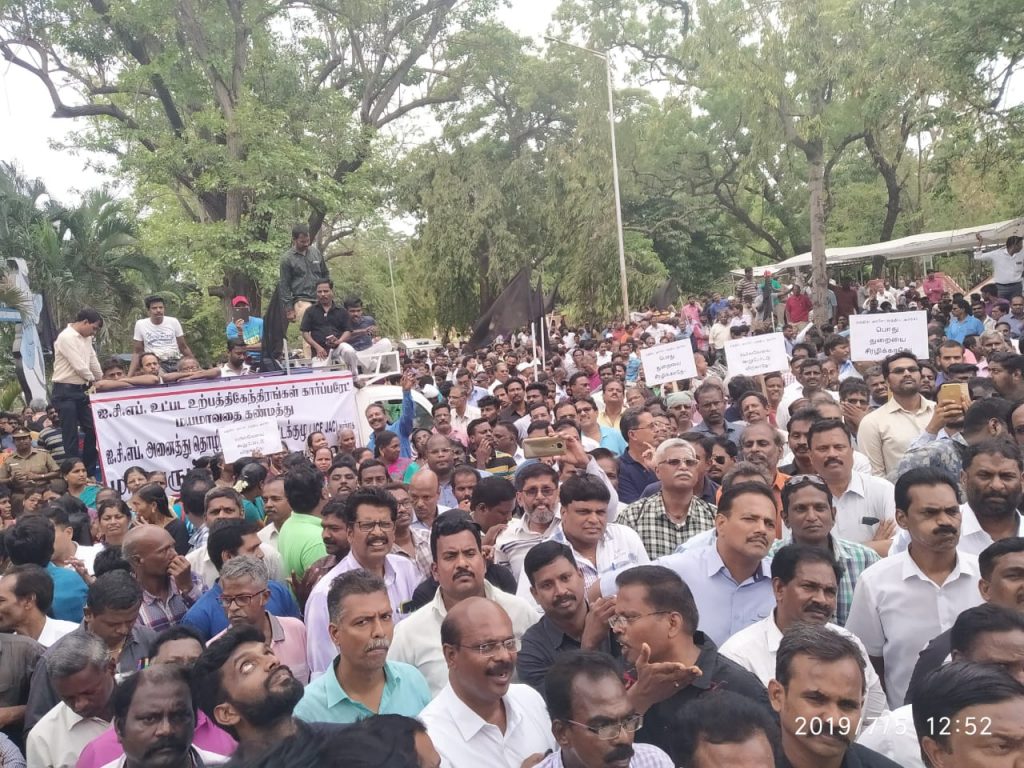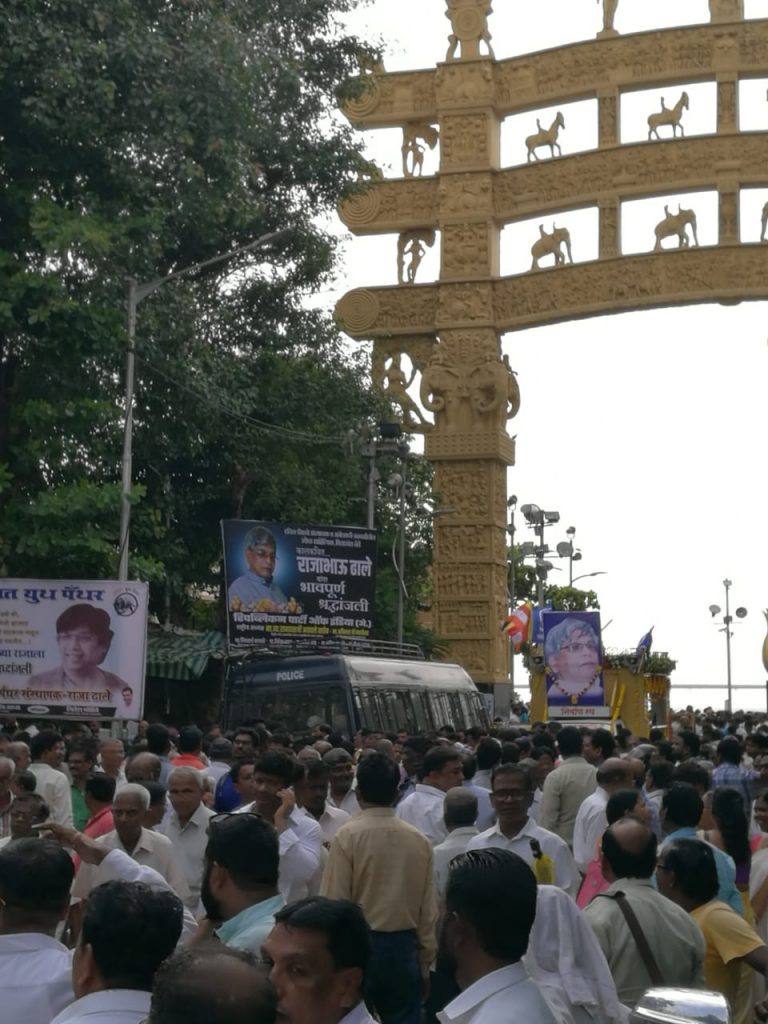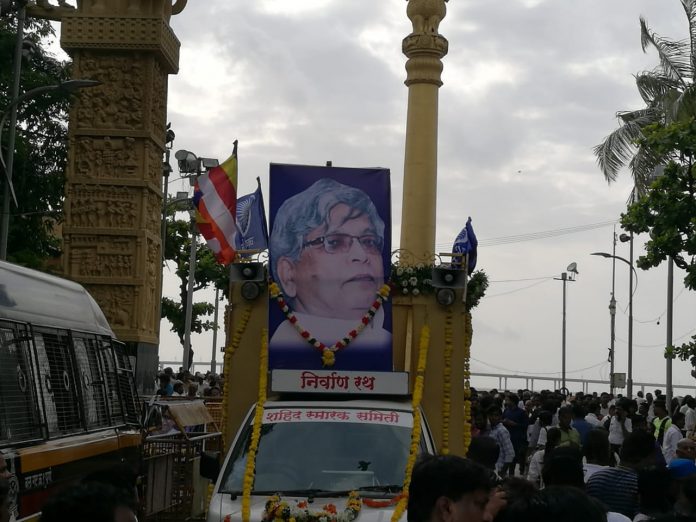Daisy K for Twocircles.net
Ambedkarites across Mumbai paid homage to Raja Dhale the co-founder of Dalit Panthers of Maharashtra.Raja Dhale 78, passed away at his residence in Vikhroli in Mumbai on Tuesday. Thousand of Ambedkarites across Mumbai assembled at Chaityabhoomi, where Dhale was cremated late afternoon in Mumbai.
Raja Dhale was born in Sangli District of Maharashtra on 30th September,1940. Dhale came to Mumbai as a youngster, where he resided at the BDD chawl in Worli. Later as a youth around 1970s Dhale enrolled in Siddharth College which is part of Peoples Education Society established by Dr. Babasaheb Ambedkar. It was there that he met his contemporaneous and future co-founders of Dalit Panthers Namdeo Dhasal and JV Pawar. Dhale was then a resident of Siddharth Vihar Hostel were many meetings related to increasing atrocities in Maharashtra took place.
Mumbai based activist Jaywant Hire recalls, “ It was during the 70s when famed writer M.N Wankhede wrote an article on Black Panthers. This was a turning point for many of us including Raja Dhale, as it left a lasting impression on us. Later this led to the formation of Dalit Panthers”. Not only did Dhale emerged as a fiery voice of the Ambedkarite movement but was a literary maverick who challenged the Brahmin hegemony over Marathi literature. Dhale was one of the key pioneers of the Little Magazine Movement which published magazines like Yeroo, Tapsee,Vidroh, Jatak, Samdrushti etc.

Subsequently, Dalit Panthers which was formed in 1972 was gaining momentum in Mumbai and other cities like Nagpur in Maharahstra.It was during the 70s that Shiv Sena too was causing a stir in Mumbai and rest of Maharashtra with their political rhetoric with the support of Congress Party. The Dalit Panthers emerged as strong critic and ideological opponent of the right wing. Dalit Panthers publically critiqued the Hindu religious books which were the proponents of caste system and atrocities. Co- founder of Dalit Panthers J V Pawar in his book Dalit Panthers: An Authoritative History mentions about the particular incident about the burning of Gita known as Gita Dahan ..in public meetings, Dalit Panthers were not only speaking against the religious texts that were the origin of caste atrocities but also threatening to publicly burn such holy books in protest. The venue for the public “bonfire” that we had announced was Shivaji Park. This was where the Shiv Sena used to hold its rallies. Dhale fished out a copy of the Gita from his pocket and Sathe gave him a matchbox. Dhale set the Gita on fire. The police personnel were now expecting it and immediately pounced on Dhale and snatched the half-burnt Gita. The police columns moved swiftly. They made a human chain around us, picked us up and pushed us into the waiting police vans. The intelligence department, as usual, fed reporters with the slanted story (next day) that Dhale had indulged in communal hatred, had denied that the Gita was a holy text and tried to burn the Gita. The reports stated that the police had foiled the attempt to publicly burn the Gita and arrested 264 youths.
With increasing atrocities in Maharashtra, Dhale penned his fiery piece in the Magazine titled Sadhanaa regarding the national flag. The magazine was run by editor S M Joshi from Pune called Kala Swatantra Din ( Black Independence Day). The context was the 25th year of independence in 1972 which the then Prime Minister Indira Gandhi had declared to be celebrated with much fanfare, this also resulted to various groups to push for their demands. Dhale was angered by a case where a Dalit women was harassed by upper caste villagers in a village in Maharashtra. Dhale retorted in the article that to outrage the modesty of women the fine is just 50 Rs but when the national flag is insulted we have to pay 300 Rs ! . He wrote in the article. “ “A Brahmin woman is not disrobed in Brahmangaon, but a Buddhist woman is. And what is the punishment for it?” (quoted from Pawar, J.V.. Dalit Panthers: An Authoritative History. Forward Press Books).It is this discrepancy that led him to pen the article which called for severe punishment to atrocities on Buddhist women. This article caused a furor in Maharashtra. Many cases were registered against Dhale after the article was published. Dhale was stern that he will not apologize to anyone regarding his views expressed in the article. Even the police feared arresting him due to the public outrage. He was let off by the police in a day after his arrest. Ultimately it was Editor S M Joshi who issued an apology.
In another instance, there was a call given by Raja Dhale and the Dalit Panthers to regard Republic Day as a Black day in the context of martyrdom anniversary of the first martyr of Dalit Panther movement, Bhagwat Jadhav. There were other instances also later where the administration and police system in Maharashtra targeted Dhale and the Dalit Panthers for their uncompromising positions. On 26th January 1975, Raja Dhale said that Dalits should treat every Republic Day as Black Day till the provisions in the Constitution is not entirely implemented. These criticism and democratic marches that Dalit Panthers led were constructed in police and intelligence agency reports as seditious and anti-state activities like preventing chief minister from hoisting national flag. Through these reports, a discourse of anti-Dalit Panther feeling was propagated , though none of these affected the spread of Panther ideology and organisation.
 Not only was Dhale a fiery activist and writer, he was an artist as well. His illustrations can be seen in many of the magazines and books which were part of the Little Magazine movement. Mumbai based Artist and Academic Dr. Sunil Awchar said that, “ Raja Dhale was an excellent artist, he developed an Ambedkarite perspective towards art and also foregrounded that Indian art is caste based and hence it has not been able to flourish. His sketches of Nagkanya and Naga figures of Karle Caves (Buddhist rock cut caves) in Maharashtra are an important contribution to our cultural heritage”.
Not only was Dhale a fiery activist and writer, he was an artist as well. His illustrations can be seen in many of the magazines and books which were part of the Little Magazine movement. Mumbai based Artist and Academic Dr. Sunil Awchar said that, “ Raja Dhale was an excellent artist, he developed an Ambedkarite perspective towards art and also foregrounded that Indian art is caste based and hence it has not been able to flourish. His sketches of Nagkanya and Naga figures of Karle Caves (Buddhist rock cut caves) in Maharashtra are an important contribution to our cultural heritage”.


